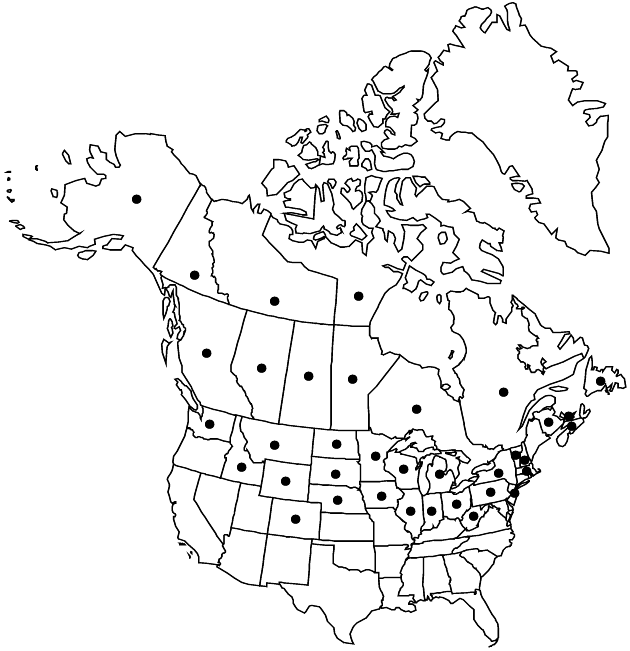Symphyotrichum boreale
Taxon 31: 358. 1982.
Perennials (5.5–)13–85 cm, colonial; slender (0.6–2.8 mm diam.), long-rhizomatous (rhizomes of season shallow- or deep-seated, not producing rosettes near parent stems). Stems 1–3+, erect (straight, slender, often reddish to slightly glaucous proximally), glabrous. Leaves stiff, margins entire to sparsely subserrulate, revolute, scabrellous, apices mucronulate, sometimes with callous point, faces glabrous, abaxial midveins sometimes sparsely strigillose; basal withering by flowering, subpetiolate to petiolate, petioles winged, base dilated, sheathing, eciliate, blades linear-oblanceolate to ovate or suborbiculate, 20–150 × 5–60 mm, bases attenuate, margins shallowly serrate or entire, apices obtuse to rounded; proximal cauline withering by flowering, sessile or subpetiolate, petioles widely winged, bases strongly clasping, blades linear-lanceolate to linear, 15–90 × 2–12 mm, bases attenuate to cuneate or subauriculate, ± clasping, apices obtuse to acute; distal sessile, blades linear-lanceolate (sometimes lanceolate) to linear, (40–)60–150 × 2–6(–8) mm, ± reduced distally, bases subauriculate, subclasping, margins entire or sometimes remotely serrulate, apices acute. Heads borne singly or in open, often lax, racemiform or paniculiform arrays, branches ascending, sparsely leafy. Peduncles 0.5–5 cm, glabrous, bracts 1–3, remote, linear-lanceolate to linear, reduced distally, not grading into phyllaries (sometimes subtending heads). Involucres cylindro-campanulate, (4–)5–8 mm. Phyllaries in 4–5 series, usually appressed, rarely outer recurved, lanceolate or oblong-lanceolate (outer) to linear (innermost) ± unequal to sometimes subequal, bases indurate 1/3–1/2 (sometimes not indurate), margins scarious, erose, hyaline or tinged with reddish purple, sparsely ciliolate, green zones lanceolate to linear-lanceolate, apices acute to acuminate, mucronate to apiculate, often purple or reddish purple (particularly inner), faces glabrous. Ray florets (15–)25–35(–41); corollas white to often pale rose, pale purple or lavender, laminae (7–)10–15(–20) × 1.1–1.5 mm. Disc florets (15–)25–30(–40); corollas cream or pale yellow becoming pink or brown purple, 3.7–6.6 mm, tubes shorter than funnelform throats, lobes triangular, 0.5–1 mm. Cypselae yellowish tan or purple to brownish with purple streaks or grayish tan (nerves stramineous), obovoid, ± compressed, 0.6–2 mm, 3–5-nerved, faces sparsely strigillose; pappi white, 2.7–6.4 mm. 2n = 16, 32, 48, 64.
Phenology: Flowering Aug–Oct.
Habitat: Mostly calcareous areas, fens, marshes, bogs, open cedar-tamarack-spruce swamps, stream and pond margins, wet meadows, swales
Elevation: 0–1500+ m
Distribution

Alta., B.C., Man., N.B., Nfld. and Labr. (Nfld.), N.W.T., N.S., Nunavut, Ont., P.E.I., Que., Sask., Yukon, Alaska, Colo., Idaho, Ill., Ind., Iowa, Mass., Mich., Minn., Mont., Nebr., N.H., N.J., N.Y., N.Dak., Ohio, Pa., S.Dak., Vt., Wash., W.Va., Wis., Wyo.
Discussion
Some of the western populations originally determined as Symphyotrichum boreale in western Wyoming and adjacent Montana are referable to S. welshii. Those of eastern Wyoming, Colorado, and the Black Hills are S. boreale. There is a gap between the ranges of the two species in Wyoming where neither occurs. Symphyotrichum ×longulum (E. Sheldon) G. L. Nesom (syn. Aster longulus E. Sheldon), reported from Minnesota, is the hybrid between S. boreale and S. puniceum var. puniceum.
Selected References
None.
